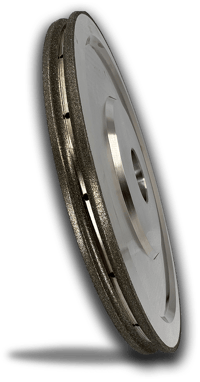Precision Beveling Automotive Glass with Diamond Metal Bond Wheels
To achieve precise beveled edges and radiused edges, the use of a diamond glass wheel is paramount. In this article, we will explore the art of beveling automotive glass with a diamond metal bond wheel, uncovering the benefits, techniques, and considerations involved in this specialized process.
Understanding Beveling Automotive Glass
Automotive glass beveling involves creating angled or radiused edges on glass surfaces, improving both the visual appeal and functionality of vehicle windows and mirrors, this operation also makes the glass easier (and safer) to handle when installing and retrofitting. Beveled edges provide a sleek and polished appearance while minimizing the risk of sharp edges and potential injury.
The Role of a Diamond Metal Bond WheelA diamond metal bond wheel is a specialized grinding tool designed for precision and durability. Composed of diamond particles securely held within a metal bond matrix, this wheel offers exceptional cutting performance, longevity, and heat dissipation, making it ideal for beveling automotive glass.
The Benefits of Using a Diamond Metal Bond Wheel
Superior Precision: A diamond metal bond wheel ensures precise and accurate beveling, resulting in clean and uniform edges.
Enhanced Durability: The robust metal bond matrix of the wheel withstands the high pressures and abrasive forces encountered during the beveling process, ensuring longevity and cost-effectiveness.
Efficient Heat Dissipation: The metal bond helps dissipate heat generated during grinding, minimizing the risk of thermal damage to the glass.
Reduced Glass Chipping: The combination of diamond abrasives and the metal bond matrix reduces the likelihood of glass chipping, providing a smooth and chip-free beveled edge.
Techniques to Prevent Glass Chipping while Beveling
To minimize glass chipping during the beveling process, it is essential to follow these techniques:
- Select the appropriate diamond grit size for the desired bevel width and surface finish.
- Maintain consistent and controlled grinding pressure to prevent excessive force on the glass.
- Ensure proper alignment and stability of the glass during the beveling process.
- Utilize coolant or lubrication to regulate heat and flush away grinding debris.
Choosing the Right Grit Size for Automotive Glass Beveling
The selection of the grit size depends on the desired bevel width and surface finish. Consider the following factors:
- Coarse grit sizes (lower numbers) are suitable for faster material removal and wider bevels.
- Fine grit sizes (higher numbers) are ideal for achieving smoother surface finishes and narrower bevels.
Beveling automotive glass with a diamond metal bond wheel is a precise and intricate process that adds elegance and functionality to vehicles. By employing the right techniques, utilizing the benefits of a diamond metal bond wheel, and carefully selecting the appropriate grit size, automotive glass professionals can achieve stunning beveled edges that meet the highest standards. Embrace the art of beveling automotive glass with a diamond metal bond wheel, and unlock a world of precision and elegance for your vehicle designs.
Recent Posts
Subscribe to email updates
Subscribe to our blog to get the latest updates from the experts on Grinding Wheels! You can easily unsubscribe at any time






